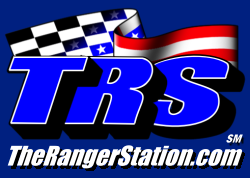Introduction
The Ranger Station has been the leading online Ford Ranger resource since 1999. This guide covers wheelbase, dimensions, towing, payload, seating, interior space, engines, horsepower, torque, fuel economy, and safety for every Ford Ranger generation from 2025 back to 1983. Be sure to check out the ‘Related Articles’ section at the bottom of this page.
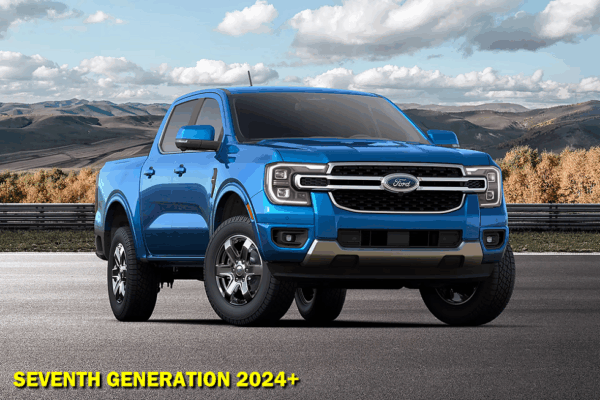
2024–2025 Ford Ranger
Wheelbase
- SuperCrew: 128.7 in
Length
- 210.6 in
Interior Space
- Front Headroom: 41 in
- Front Legroom: 43.7 in
- Rear Legroom: 34.6 in
Capacities
- Towing: 7,500 lbs
- Payload: 1,700–1,805 lbs
- Seating: 5
Engines
- 2.3L EcoBoost – 270 hp / 310 lb-ft
- 2.7L EcoBoost V6 – 315 hp / 400 lb-ft
- 3.0L EcoBoost V6 (Raptor) – 405 hp / 430 lb-ft
Fuel Economy
- 2.3L: 21–24 mpg
- 2.7L: 19–23 mpg
- Raptor: 15–18 mpg
Safety
- Full modern ADAS; 5-star capable.
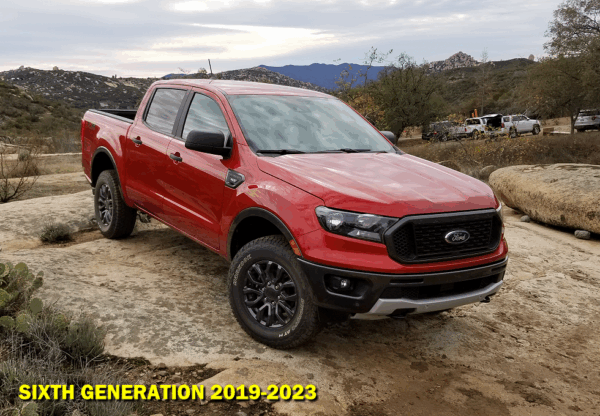
2019–2023 Ford Ranger
Wheelbase
- SuperCab: 126.8 in
- SuperCrew: 126.8 in
- SuperCrew 6-ft Bed: 128.7 in
Length
- 210.8 in
Interior Space
- Front Headroom: 40.8 in
- Front Legroom: 43.1 in
- Rear Legroom (SuperCrew): 34.5 in
Capacities
- Towing: 7,500 lbs
- Payload: up to 1,860 lbs
- Seating: 4–5
Engine
- 2.3L EcoBoost I4 – 270 hp / 310 lb-ft
Fuel Economy
- 21–26 mpg
Safety
- Modern crash ratings: Good / 5-Star range.
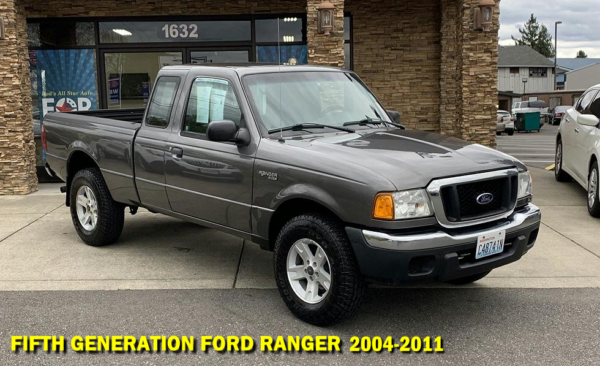
2004–2011 Ford Ranger
Wheelbase
- Regular Cab Short Bed: 111.5 in
- Regular Cab Long Bed: 117.5 in
- SuperCab: 125.7 in
Length
- 188–203 in
Interior Space
- Headroom: 39.2 in
- Legroom: 42.4 in
Capacities
- Towing: 3,100–5,800 lbs
- Payload: 1,260–1,810 lbs
- Seating: 3 / 4
Engines
- 2.3L I4 (143 hp)
- 3.0L V6 (148 hp)
- 4.0L SOHC V6 (207 hp)
Fuel Economy
- 21–27 mpg (I4) | 15–21 mpg (V6)
Safety
- ABS standard; side airbags optional.

1998–2003 Ford Ranger
Wheelbase
- Regular Cab Short Bed: 111.5 in
- Regular Cab Long Bed: 117.5 in
- SuperCab: 125.7 in
Length
- 188–203 in
Interior Space
- Headroom: 39.2 in
- Legroom: 42.4 in
Capacities
- Towing: 3,000–5,980 lbs
- Payload: 1,260–1,860 lbs
- Seating: 3 / 4
Engines
- 2.5L I4 (117 hp)
- 3.0L V6 (150 hp)
- 4.0L OHV & SOHC V6 (160–207 hp)
Fuel Economy
- 20–25 mpg (I4) | 15–21 mpg (V6)
Safety
- Improved airbags & structure; “Marginal–Acceptable” crash ratings.

1993–1997 Ford Ranger
Wheelbase
- Regular Cab Short Bed: 108.3 in
- Regular Cab Long Bed: 112 in
- SuperCab: 125.9 in
Length
- 176–203 in
Interior Space
- Headroom: 39.2 in
- Legroom: 42.4 in
Capacities
- Towing: 3,000–5,600 lbs
- Payload: 1,300–1,800 lbs
- Seating: 3 (RC) / 4 (SuperCab)
Engines
- 2.3L I4 (98 hp)
- 3.0L V6 (145 hp)
- 4.0L OHV V6 (160 hp)
Fuel Economy
- 21–26 mpg (I4) | 16–21 mpg (V6)
Safety
- Driver airbag standard.
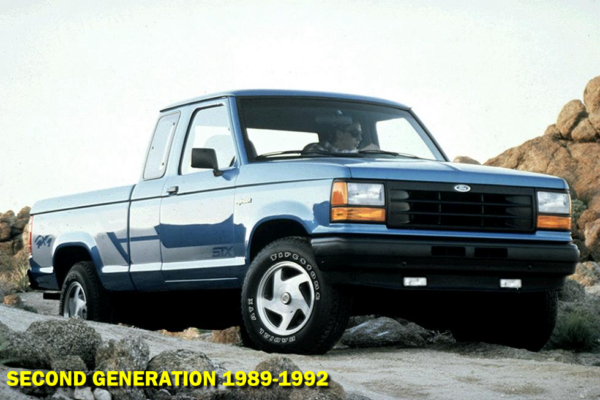
1989–1992 Ford Ranger
Wheelbase
- Regular Cab Short Bed: 108 in
- Regular Cab Long Bed: 114 in
- SuperCab: 114 in
Length
- 175–193 in
Interior Space
- Headroom: 38.5–39 in
- Legroom: 42–43 in
Capacities
- Towing: 2,000–3,000 lbs
- Payload: 1,300–1,800 lbs
- Seating: 3 / 4
Engines
- 2.3L I4
- 2.9L V6
- 3.0L V6
- 4.0L V6 (160 hp)
Fuel Economy
- 20–26 mpg (I4) | 15–20 mpg (V6)
Safety
- No airbags; basic 1990s standards.

1983–1988 Ford Ranger
Wheelbase
- Regular Cab Short Bed: 108 in
- Regular Cab Long Bed: 114 in
- SuperCab: 114 in
Length
- Approx. 175–186 in
Interior Space
- Headroom: 38–39 in
- Legroom: 42–43 in
Capacities
- Towing: 1,500–2,000 lbs
- Payload: 1,200–1,600 lbs
- Seating: 3 (Regular Cab), 4 (SuperCab with jump seats)
Engines
- 2.0L I4 (73 hp)
- 2.3L I4 (79–86 hp)
- 2.8L V6 (115 hp)
- 2.9L V6 (140 hp)
- 2.3L Diesel
Fuel Economy
- Gas: 17–23 mpg | Diesel: mid-20s mpg
Safety
- No airbags, no modern crash ratings.
Fuel Economy
For a more detailed breakdown of the Ford Ranger fuel mileage ratings from 1983-2011, check out:
Ford Ranger Fuel Mileage Ratings
How Much Larger Is The 2019-2025 Ford Ranger Than Previous Models:
Here is a look at the 2011 Ford Ranger next to a 2019 Ford Ranger that replaced it after being absent from the North America market for 8-years.

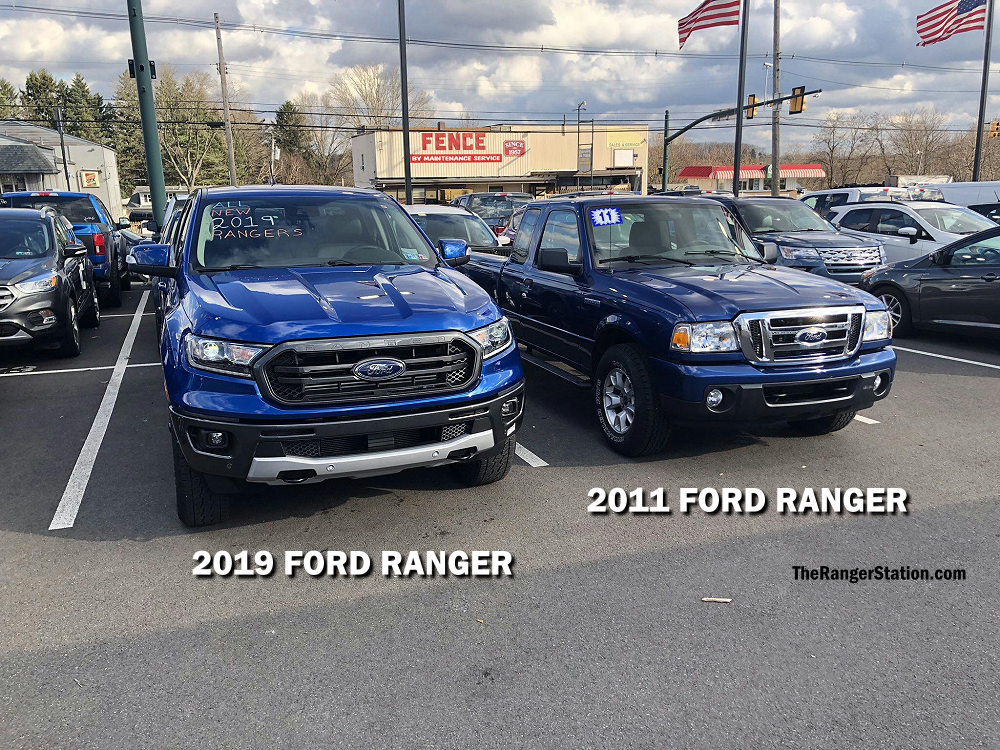
2011 Ford Ranger vs 2019 Ford Ranger Differences / Dimensions
| Difference | ||||
| 2011 Ranger | 2019 Ranger | in | % | |
| Wheelbase | 125.9″ | 126.9″ | 0.9″ | 1% |
| Length, Overall w/o rear bumper | 203.6″ | 210.8″ | 7.2″ | 3% |
| Width, Max w/o mirrors | 71.3″ | 73.3″ | 2″ | 3% |
| Height, Overall | 67.7″ | 71.1″ | 3.4″ | 5% |
| Overhang, Front | 34″ | 35.8″ | 1.8″ | 5% |
| Overhang, Rear w/o bumper | 49.9″ | 48.2″ | -1.7″ | -4% |
| Ground Clearance, Front | 8.9″ | 8.9″ | 0″ | 0% |
| Ground Clearance, Rear | 8.9″ | 8.9″ | 0″ | 0% |
| Cargo Box Length @ Floor | 72.7″ | 72.8″ | 0.1″ | 0% |
| Cargo Box Width @ Floor | 54.4″ | 61.4″ | 7″ | 11% |
| Cargo Box Width @ Wheel housings | 40.5″ | 44.8″ | 4.3″ | 10% |
| Cargo Box (Area) Height | 16.5″ | 20.8″ | 4.3″ | 21% |
| Cargo Volume, cu-ft | 43.6″ | 51.8″ | 8.2″ | 16% |
1983-2025 Ford Ranger Specification Table
| Generation (Years) | Wheelbases (Cab/Bed) | Engines Available | Max Towing | Max Payload | Headroom / Legroom | Seating |
|---|---|---|---|---|---|---|
| 1983–1988 (1st Gen) | RC SB: 107.9″ RC LB: 113.9″ SuperCab: 125.0″ |
2.0 I4 (72 hp) 2.3 I4 (79–100 hp) 2.8 V6 (115 hp) 2.9 V6 (140 hp) 2.2 Diesel I4 |
Up to 5,600 lbs | Up to 1,600 lbs | RC: 39.2″ / 42.0″ SC: 39.2″ / 32.0″ |
2–4 |
| 1989–1992 (2nd Gen) | RC SB: 107.9″ RC LB: 113.9″ SuperCab: 125.0″ |
2.3 I4 (100 hp) 2.9 V6 (140 hp) 4.0 V6 (160 hp) |
Up to 6,000 lbs | Up to 1,600 lbs | RC: 39.2″/42.0″ SC: 39.2″/32.0″ |
2–4 |
| 1993–1997 (3rd Gen) | RC SB: 107.5″ RC LB: 113.9″ SuperCab: 125.7″ |
2.3 I4 (98 hp) 3.0 V6 (145 hp) 4.0 V6 (160 hp) |
Up to 6,000 lbs | Up to 1,580 lbs | RC: 39.2″/42.4″ SC: 39.2″/30.7″ |
2–4 |
| 1998–2003 (4th Gen) | RC SB: 111.5″ RC LB: 117.5″ SuperCab: 125.7″ |
2.5 I4 (119 hp) 3.0 V6 (150 hp) 4.0 SOHC V6 (207 hp) |
Up to 6,000 lbs | Up to 1,580 lbs | RC: 39.2″/42.4″ SC: 39.2″/30.7″ |
2–4 |
| 2004–2011 (5th Gen) | RC SB: 111.5″ RC LB: 117.5″ SuperCab: 125.7″ |
2.3 I4 (143 hp) 3.0 V6 (148 hp) 4.0 SOHC V6 (207 hp) |
Up to 6,000 lbs | Up to 1,600 lbs | RC: 39.2″/42.4″ SC: 39.2″/30.7″ |
2–4 |
| 2019–2023 (6th Gen, Return) | SuperCab 6′ Bed: 126.8″ Crew Cab 5′ Bed: 126.8″ |
2.3 EcoBoost I4 (270 hp / 310 lb-ft) | Up to 7,500 lbs | Up to 1,860 lbs | SC: 41.0″/30.4″ CC: 39.8″/34.5″ |
4–5 |
| 2024–2025 (7th Gen) | SuperCab 6′ Bed: 126.8″ Crew Cab 5′ Bed: 128.7″ |
2.3 EcoBoost (270 hp) 2.7 EcoBoost V6 (315 hp) 3.0 EcoBoost V6 Raptor (405 hp) |
Up to 7,500 lbs | Up to 1,805 lbs | SC: 41.0″/30.4″ CC: 39.8″/34.6″ |
4–5 |
Related Articles
What’s The Difference Between The Ford Ranger FX4 & Tremor
2021 Ford Ranger Tremor – Best Ford Ranger Ever?
First Drive: 2019 Ford Ranger On/Off Highway
Ford Ranger Trail Control & Terrain Management
Introduction: 2019 Ford Ranger
1983-2011 Ford Ranger’s Buyers Guide
Ford Ranger Generations 1983-Present
Ford Ranger Fuel Mileage Ratings
About The Author:
Jim Oaks is the founder of TheRangerStation.com, the longest-running Ford Ranger resource online since 1999. With over 25 years of hands-on experience building and modifying Ford Rangers — including magazine-featured builds like Project Transformer — Jim has become one of the most trusted authorities in the Ford Ranger off-road and enthusiast space. In 2019, he was loaned a Ranger FX4 by Ford Motor Company to test and document across the TransAmerica Trail. Jim continues to inspire and guide Ranger owners around the world.
